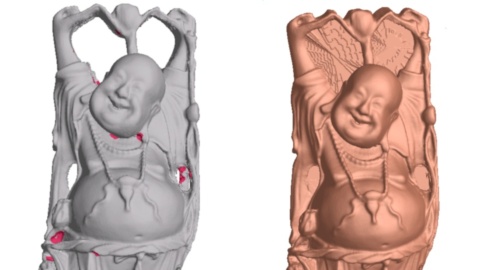Removing excess topology from isosurfaces

ACM Trans. Graphics, 23(2), April 2004, 190-208.
Repair of tiny topological handles in scanned surface models.
Abstract:
Many high-resolution surfaces are created through isosurface extraction from volumetric representations,
obtained by 3D photography, CT, or MRI. Noise inherent in the acquisition process can lead to geometrical
and topological errors. Reducing geometrical errors during reconstruction is well studied. However,
isosurfaces often contain many topological errors in the form of tiny handles. These nearly
invisible artifacts hinder subsequent operations like mesh simplification, remeshing, and parametrization.
In this article we present a practical method for removing handles in an isosurface. Our algorithm makes
an axis-aligned sweep through the volume to locate handles, compute their sizes, and selectively remove
them. The algorithm is designed to facilitate out-of-core execution. It finds the handles by
incrementally constructing and analyzing a Reeb graph. The size of a handle is measured by a short
nonseparating cycle. Handles are removed robustly by modifying the volume rather than attempting "mesh
surgery". Finally, the volumetric modifications are spatially localized to preserve geometrical detail.
We demonstrate topology simplification on several complex models, and show its benefits for subsequent
surface processing.
Hindsights:
This topologically repaired Buddha model has been used in a number of subsequent papers. Topological analysis of arbitrary meshes using Morse functions is also explored in Ni et al 2004 and Pascucci et al 2007.
This paper was previously available as the technical report MSR-TR-2002-28.
See content copyrights.